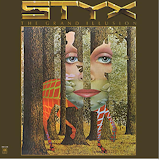Rock Album Covers |
| Sgt. Pepper's Lonely Hearts Club Band (1967), Blake |
This post will examine cover art from a dozen 20th-century designers.
 |
| Face Dances (1981), Blake et.al. |
I also love Blake's 1981 design of the "Face Dances" cover of The Who members (by row) -- Pete Townshend, Roger Daltrey, John Entwistle, and Kenney Jones -- whose portraits were painted by sixteen artists: Bill Jacklin, Tom Phillips, Colin Self, Richard Hamilton; Michael Andrews, Allen Jones, David Inshaw, David Hockney; Clive Barker, R. B. Kitaj, Howard Hodgkin, Patrick Caulfield; Peter Blake, Joe Tilson, Patrick Procktor and David Tindle. It was featured in my April 2020 post entitled, Op & Pop Artists - From Allegorical Renaissance to Modern Day Optical and Kinetic Art.
 |
| Grand Illusion (1977), Mouse Miller |
 |
| Blank Signature (1965), Magritte |
American artist Stanley "Mouse" Miller (1940-) is famous for his 1960s psychedelic rock album cover designs for the Grateful Dead, Journey, and Styx. His "Grand Illusion" Styx album is a pastiche (imitation) of Belgian Surrealist René Magritte's Blank Signature.
 |
| Felix-Wyeth |
 |
| Get Happy!! (1980), Barney Bubbles |
 |
| Swans Reflecting Elephants (1937), Salvador Dali |
 |
| Osibisa (1971), Roger Dean |
 |
| Playground Psychotics (1992), Schenkel |
I like the color scheme of the Frank Zappa and The Mothers of Invention album, Playground Psychotics, which was released in 1992. Designed by Cal Schenkel (1947-), I appreciate his black-and-white drawings of band members and Zentangle-like doodles (e.g., spirals). This is what I imagine an album cover would look like!
 |
| Powderfinger - Golden Rule (2009), Thorgerson |
Storm Thorgerson (1944-2013) designed this simple cover for the seventh and final studio album, Golden Rule, by Australian rock band Powderfinger in 2009. Their 2010 album, Sail the Wildest Stretch, also sports a more vivid version of the bird on its cover. Journey also uses a bird symbol on their albums. I wonder if the Australian band chose its name after Neil Young's 1979 song, Powderfinger.
Jazz Album Covers
 |
| Tequilla Mockingbird (1979), Glaser |
The 1979 Ramsey Lewis cover "Tequilla Mockingbird" was produced under the direction of Paula Scher and John Berg and illustrated by Milton Glaser (1929-2020). I like its simplicity and movement with its bright rainbow colors against a black background. The jagged lettering of the title deconstructs it into the familiar "To Kill a Mockingbird".
 |
| Basie and Williams (1956), Martin |
Jazz album covers are typically very graphic and often in a red-black-and-white color scheme. The drawings were cartoon-like and usually included musical instruments. Here are covers by David Stone Martin (1913-1992) and Reid Miles (1927-1993). See the link for more of Martin's covers. I love the watercolor touches on this particular cover.
 |
| A Swingin' Affair (1963), Reid Miles |
This cover for saxophonist Dexter Gordon was designed by Reid Miles. Although it has a photographic portrait of the musician, I love the composition of red against the black background. You can see more at The Album Cover Art at Blue Note Records.
Artsy Album Covers
 |
| New Order - Technique (1989), Saville |
These last three covers are much more like paintings than album covers. For New Order's Technique album, Peter Saville (1955-) colorized a cherubic garden ornament complete with psychedelic colors. Apparently, it went well with the vibe of this electronic dance band's music. I imagine the cherub playing an invisible air guitar.
 |
| Atomic Playboys (1989), HR Giger |
Surrealist artist HR Giger's (1940-2014) Atomic Playboys cover was created for guitarist Steve Stevens' (born Steven Bruce Schneider in 1959) first studio album. Its rather gothic design includes a guitar fret. He was Billy Idol's guitarist and songwriting collaborator, who also played for Michael Jackson, Ric Ocasek, Robert Palmer, and others.
 |
| The Bleeders (2008), Vaughan Oliver |
British graphic designer Vaughan Oliver (1957-2019) produced this cover for the Bleeders in 2008. It reminds me of the works of abstract expressionists, which have been created by many of my favorite artists. It doesn't look like an album cover, but I really like its contrasting colors and white highlights!
I hope you enjoyed reading this post as much as I have researching it. Please visit the links, especially the other jazz covers. You may also wish to comment naming your favorite album cover!










